Robyn Stacey | herbarium - background

Given its botanical significance and physical fragility, the herbarium collection is not accessible to the public and never travels. At the same time, the Royal Botanic Gardens Sydney recognises that the collection is an important cultural repository both nationally and internationally. herbarium is one way of returning the collections to the public.
White settlement of Australia coincided with a great interest in Europe in natural history and the expanding empires of Britain and France in particular led to the introduction into Europe of many new botanical species. At the same time, the introduction by Linnaeus of the binomial system of nomenclature meant there was a practical method of documenting and comparing the plants of the world.
The genesis of botanical science in Australia was also aided by the fact that botanical material was no longer being presented purely in Latin but works were beginning to appear in the language of the author. Thus at the time of the founding of the colony at Port Jackson, interest in botanical material was combined with artistic representations of plants accompanied by a description of the plant often in the language of the country. Cultural, scientific and artistic influences came together in the late eighteenth century to spark both a scientific and popular interest in Australian botanical material.
"When a botanist first enters on the investigation of so remote a country as New Holland, he finds himself as it were in a new world. He can scarcely meet with any fixed points from whence to draw his analogies; and even those that appear promising, are frequently in danger of misleading, instead of informing him. The whole tribe of plants which first seem familiar to his acquaintance, as occupying Nature’s chain, on which he is accustomed to depend, prove, on nearer examination, total strangers, with other configurations, and other qualities; not only the species themselves are new, but most of the genera and even natural orders.”
J.E. Smith, A Specimen of the Botany of New Holland, London, 1793.
It is difficult for us to understand the level of interest in the plants from Australia, people queued on the docks in London waiting for the ship to unload specimens or plants. As well as the scientific significance of the plants from New Holland there was a considerable amount of social prestige attached to these 'antipodean oddities'. If you were a gentleman of any repute, three things were required, a collection, a library and a garden. And the jewel in the crown was to have a garden with Australian plants. There are letters in the Mitchell library from Lord Bathurst to the colonial secretary ordering waratahs to be dispatched to the King of Bavaria on the next ship leaving New South Wales.
Saturday in colonial Sydney was referred to as collecting day. You collected to send specimens back to family and friends to show how strange and bizarre the flora and fauna of Australia was, you collected to sell to wealthy patrons in Europe, or you collected for botanical/ scientific reasons to help understand how Australian flora and fauna fitted into the global scheme of the natural world.
While the herbarium collection is still growing today the early collection material was amassed not only by professional botanists and naturalists, but significantly by hobby collectors, who cross all socio-economic groups, from the gentleman scholar, retired scientists and professors, clergy, and lay people from all walks of life including women (Botany being one of the few activities that women could engage in outside of the home).
The work of the hobby collector is most obvious in the algae and fern albums that were incredibly popular in the nineteenth century. The forms chosen to conserve or display the specimens collected by the hobbyist often utilise artistic arrangements on coloured backgrounds making for variation and allowing for individual expression. The scientific specimen sheet on the other hand has a unified dimension which never varies and utilises a white background to represent scientific objectivity and rationalism.